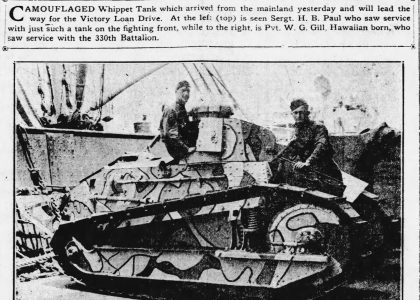Born on November 29, 1890, in Kehena, Puna, on the island of Hawaiʻi, Henry Kolomoku Unuiwi (also recorded in historical documents as Umuiwi or Unuivi) was the son of Wahinemaikai and John Unuiwi. Tragedy struck early in his life—his mother died when he was an infant. He was then raised by a family friend, Mrs. Mary Maka, who nursed and cared for him in Pahoa.
Henry came from a close-knit Hawaiian family, though it was marked by loss. He had two brothers, both of whom were also named Henry. One died in a locomotive accident at Olaa when he was a boy. The other, Henry Keaweopala, would be the only one of the three boys to reach age 30.
Henry Kolomoku enlisted in the U.S. Army on April 1, 1918, joining Company E of the 146th Infantry, 37th “Buckeye” Division. On June 15, 1918, he departed from Hoboken, New Jersey, aboard the transport ship Leviathan, bound for Europe and war.
In September 1918, Henry’s division took part in the Meuse–Argonne Offensive, one of the largest and bloodiest operations of World War I. During the initial push on September 26, the 37th Division, new to the front and still gaining its footing, struggled to advance. Just four days later, on September 30, Private Henry Kolomoku Unuiwi was killed in action. The very next day, General John J. Pershing ordered a pause in the offensive. Henry’s sacrifice came just weeks before the armistice that ended the war.
After the war, his remains were repatriated to Hawaii. On October 23, 1921, a military funeral was held in Hilo—the first of its kind in the town. Adjutant William L. Serrao of the American Legion paid tribute: “He bravely laid down his life for the cause of his country. His name will ever remain fresh in the hearts of his friends and comrades.” The funeral included full military honors, with a ceremony at the Hilo Armory followed by a burial at Homelani Memorial Park.
Today, Henry Kolomoku Unuiwi’s name is inscribed on the Honor Roll commemorating the sons of Hawaiʻi who gave their lives in the First World War. Despite the spelling inconsistencies across records—Unuiwi, Umuiwi, and Unuivi—his legacy as a young Hawaiian who answered the call to service remains clear and enduring.
Sources:
Soldier’s Body to Arrive in Hilo Sunday Morning. (1921, October 21). Hilo Daily Tribune, 1.
U.S., Army Transport Service Arriving and Departing Passenger Lists, 1910-1939. (n.d.). Retrieved May 14, 2025, from https://www.ancestry.com/imageviewer/collections/61174/images/44509_3421606198_0044-00331?pId=3692068
U.S., Headstone Applications for Military Veterans, 1861-1985—Ancestry.com. (n.d.). Retrieved May 14, 2025, from https://www.ancestry.com/search/collections/2375/records/888477
Meuse–Argonne offensive. (2025). In Wikipedia. https://en.wikipedia.org/w/index.php?title=Meuse%E2%80%93Argonne_offensive&oldid=1282533265
Waiakea Boy Reported Killed in Action. (1918, November 13). Hawaii Tribune-Herald, 1. https://en.wikipedia.org/wiki/148th_Infantry_Regiment_(United_States)


